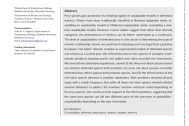Content
Prey species gain protection by imitating signals of unpalatable models in defensive mimicry. Mimics have been traditionally classified as Batesian (palatable mimic resembling an unpalatable model) or Müllerian (unpalatable mimic resembling a similarly unpalatable model). However, recent studies suggest that rather than discrete categories, the phenomenon of mimicry can be better understood as a continuum. The level of unpalatability of defended prey is a key factor in determining the type of mimetic relationship. Herein, we used insects (ladybugs and true bugs) from a putative European “red–black” mimetic complex as experimental models of defended species and crickets as a control prey. We offered the prey to two species of sympatric invertebrate predators (praying mantis and spider) and video recorded the interactions. We tested three alternative hypotheses, namely (i) the three red–black species tested are similarly defended against both predators
(ii) some red–black species are better defended than others against both predator species, and (iii) the effectiveness of the red–black species defenses is predator dependent. Both predators attacked all prey types with a similar frequency. But while all three red–black species similarly elicited aversive behaviors in spiders, the mantises' aversive reactions varied depending on the prey species. Our results provide support to the third hypothesis, suggesting that the same prey species can fall into different parts of the spectrum of palatability–unpalatability depending on the type of predator.



